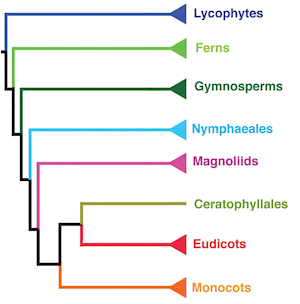Hierarchical classification
The hierachical classification system we use for classifying organisms has several levels. Closely related species are grouped into a genus; closely related genera are grouped into a family, etc. From the broadest grouping down to the smallest, most specific groups, those levels include:
Kingdom: Plantae
Phylum (or Division) (e.g., Anthophyta (=angiosperms), one of several phyla in the Kingdom Plantae)
Class (e.g., Magnoliopsida (=dicots), one of the classes in the phylum, Anthophyta)
Order (e.g., Asterales, one of several orders in the class, Magnoliopsida)
Family (e.g., Asteraceae, one of several families in the order, Asterales)
Genus (e.g., Rafinesquia, one of several genera in the family, Asteraceae)
Species (e.g, Rafinesquia californica, one of two species in the genus, Rafinesquia)
[Sometimes an infraspecific taxonomic level, such as subspecies or variety]

The Jepson manual groups plants into eight major monophyletic groups or clades that reflect the most recent classification systems of vascular plants. It is illustrated here. All of these plants have a common ancestor, but the Lycophytes (seedless vascular plants with one sporangium per leaf) diverged from other plant groups the earliest. Next, the common ancestor of seed plants diverged from the ferns (seedless vascular plants with sporangia arranged in sori on their leaves). Among the seed plants, the common ancestor of flowering plants diverged from the gymnosperms, then various groups of angiosperms (flowering plants) continued to diverge. You can click on the original version of the cladogram on the Jepson Manual website to see finer-scale phylogenetic relationships (e.g., all of the families of gymnosperms, all of the genera in one family in the gymnosperms, etc.). Follow this link: https://ucjeps.berkeley.edu/eflora/clademap/